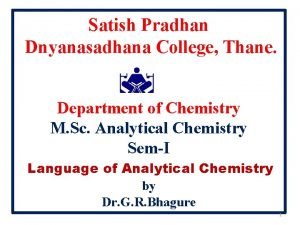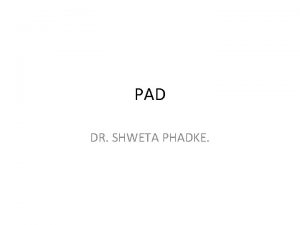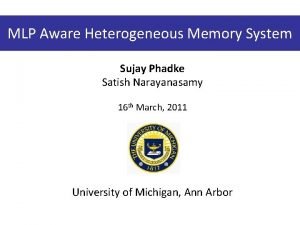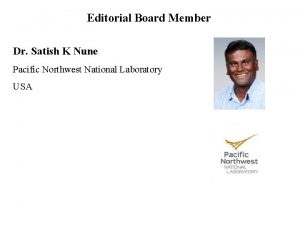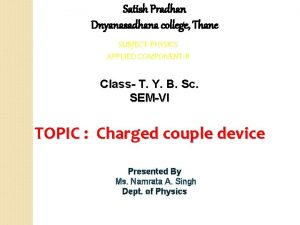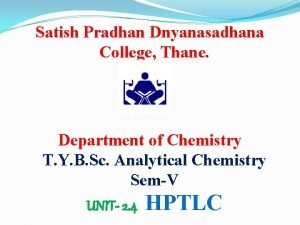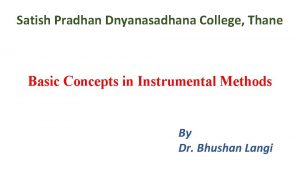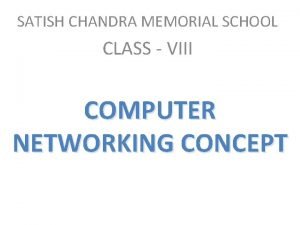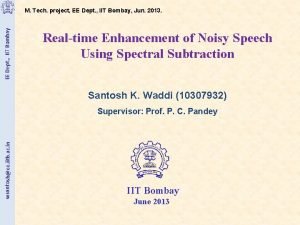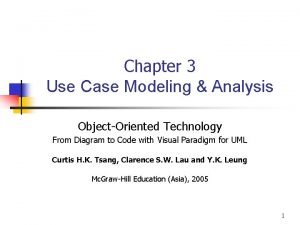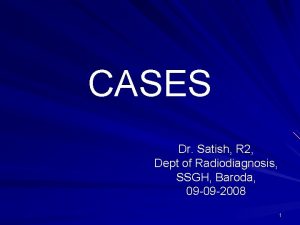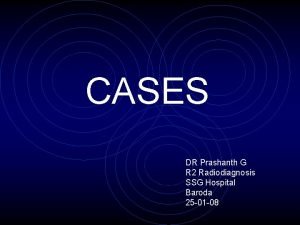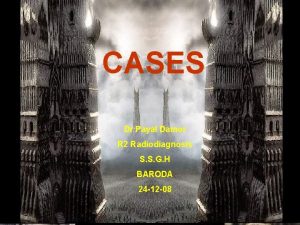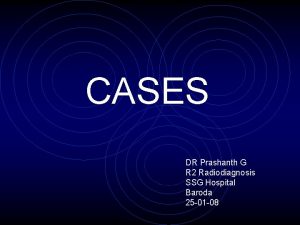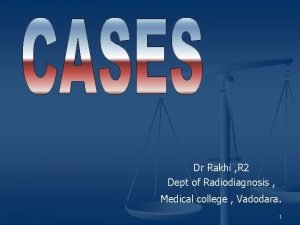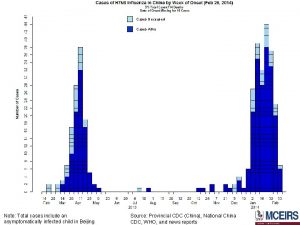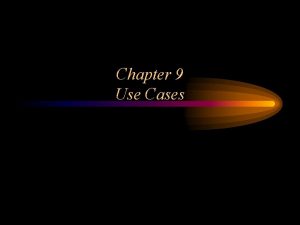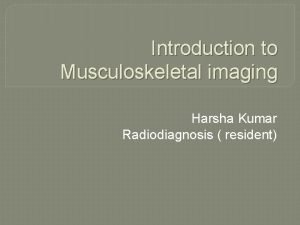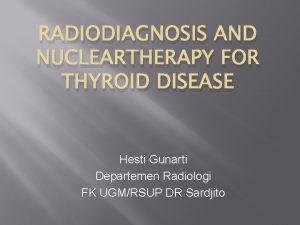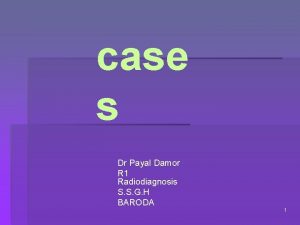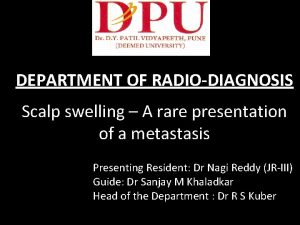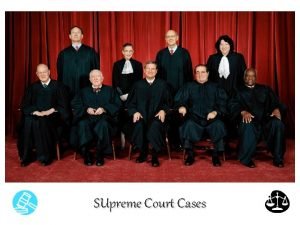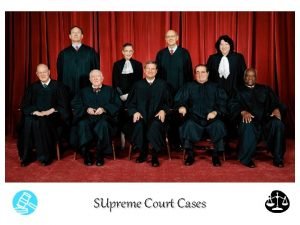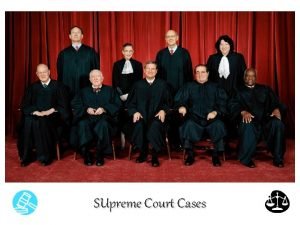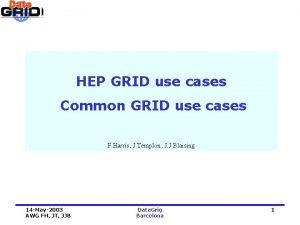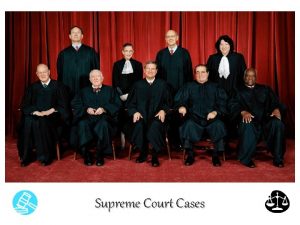CASES Dr Satish R 2 Dept of Radiodiagnosis





























































- Slides: 61

CASES Dr Satish R 2, Dept of Radiodiagnosis, SSGH, Vadodara, 28 -11 -08 1

Case 1 2

History A 47 yrs old male having facial abnormality in the form of a large mass in the region of jaw. The enlargement was slow & progressive without any pain or discharge. 3

4

5

DIFFERENTIAL DIAGNOSIS: Ameloblastoma Odontogenic Keratocyst Dentigerous Cyst 6

Cystic lesion of Jaw Odontogenic Non mineralized Mineralized Odontoma Non Odontogenic Myxoma Ameloblastoma Radicular Cyst Odontogenic Keratocyst Dentigerous Cyst 7

Non Odontogenic Cyst Benign Fibro-osseous Lesions Central Giant Cell Granuloma Traumatic Bone Cyst Lingual Inclusion Defect (Stafne’s simple bone cyst) Brown Tumor Mucoepidermoid Carcinoma Arteriovenous Malformation 8

Points to look for… History Location of the lesion within the mandible. its borders. Internal architecture. Effects on adjacent structures – Displacement, – Resorbtion of teeth. Surrounding bony changes. Other associated findings. 9

Radiologically the odontogenic & non odontogenic cysts have a number of features in common. 10

Jaw Cyst MULTILOCULAR ØODONTOGENIC KRATOCYST(LARGE) ØAMELOBLASTOMA(LARGE) ØCENTRAL GIANT CELL GRANULOMA ØBROWN’S TUMOUR ØANEURYSMAL BONE CYST UNILOCULAR ØRADICULAR CYST ØDENTIGEROUS CYST ØSTAFNE’S CYST ØSOLITARY BONE CYST ØFIBROUS DYSPLASIA(EARLY) 11

LOCATION ANTERIOR POSTERIOR ANYWHERE GIANT CELL GRANULOMA STAFNE CYST AMELOBLASTOMA DENTIGEROUS ODONTOGENIC KERATOCYST AVM TRAUMATIC CYST BROWN TUMOUR FD 12

Ameloblastoma slow-growing, painless tumour arising from dental follicular lining epithelium & occurring in 4 th-5 th decade of life. Involves ramus and posterior body of the mandible (80%). are typically expansile mutilocular with a well defined osseous shell that represents the involved bone. The involved teeth are usually displaced. CT findings usually show soft tissue attenuation although lower attenuation cystic appearance can also be seen. It can perforate the lingual cortex of the mandible and extend into the adjacent soft tissues. 13

Odontogenic Keratocyst Arise from dental lamina & represent – 15% of all jaw cysts, occurring in adolescents. 5% Site - body and ramus of the mandible Occurs as multilocular lesion with corticated margins and causes cortical thinning, tooth displacement, and root resorption. 14

Because it grows by epithelial proliferation it lacks the ballooning of radicular or dentigerous cysts & expansion extends to be more AP than buccolingual. Multiple odontogenic keratocysts, along with nevoid basal cell carcinomas and bifid ribs, are components of the Basal cell nevus syndrome (Gorlin-Goltz syndrome). 15

Dentigerous Cyst the most common type of noninflammatory odontogenic cyst associated with an impacted tooth. Occurs in adolescents and young adults & form around the crown of an unerupted mandibular third molar. 16

Dentigerous Cyst 17

So the diagnosis in our case is AMELOBLASTOMA 18

Case 2 19

History A newborn with abnormal facial features with a proboscis on the forehead. The baby died soon after birth. No similar maternal history. 20

US image of fetal head showing a large single cavity with two thalami which are fused. 21

US image showing closely spaced orbits with a small round structure on the forehead. 22

23

Diagnosis Alobar holoprosencephaly 24

Discussion Holoprosencephaly is a disorder of ventral induction in which there is failure of lateral cleavage into distinct cerebral hemispheres & failure of transverse cleavage into diencephalon & telencephalon. Associated facial anomalies result from a lack of induction of the midline segments of the face. They are divided into three types by degree of brain cleavage. 25

1. Alobar Holoprosencephaly (severe form) 2. Semi lobar Holoprosencephaly (moderate form) 3. Lobar Holoprosencephaly (mildest form) 26

Alobar Holoprosencephaly Is characterized by nearly complete lack of ventricular & hemispheric cleavage. Imaging reveals a large crescent-shaped holoventricle with a completely unsegmented rim of brain. Thalami are fused with absence of the interhemispheric fissure, falx cerebri & septum pellucidum. 27

a large dorsal cyst which occupies more than half of the volume of the calvarium is usually present. Patients have severe midline facial deformities & hypotelorism, resulting from absence or hypoplasia of the premaxillary segment of the face. In most extreme form, cyclopia (fused orbits, single eyeball) and forehead proboscis are present. Most fetuses are spontaneously (or therapeutically) aborted while infants that are carried to term are stillborn or have a very short life span 28

Semilobar Holoprosencephaly a less severe anomaly with normal facies or mild facial anomalies. There is partial but interrupted attempt at brain diverticulation. A H-shaped monoventricle with partially developed occipital & temporal horns is common. A rudimentry falx, incompletely formed interhemspheric fissure is seen. There is usually partial or complete fusion of basal ganglia with a small third ventricle. 29

Semilobar Holoprosencephaly H-shaped monoventricle with partially developed occipital & temporal horns 30

Lobar Holoprosencephaly There is near complete brain cleavage. Ventricles appear well lobulated. Absent septum pellucidum gives a box like configuration to the frontal horns. Basal ganglia are separate. A nearly completely formed falx & interhemispheric fissure is present although the most anteroinferior part may be absent & the frontal lobes fused inferiorly in the midline. The optic vesicles & olfactory bulbs may be hypoplastic but severe facial abnormalities are rare. 31

Coronal image: absent CSP & frontal horn flattening 32

Findings Alobar Semilobar Lobar Craniofacial anomalies Ventricles severe variable Septum pellucidum Falx cerebri Mild /absent monoventricle Rudimentry Squarred off occipital frontal horns Absent Partial Well formed Interhemisph Absent eric fissure Thalami/ BG Fused Partial present Partially seperated seperate 33

Other differentials include: Hydranencephaly Severe hydrocephalus Corpus callosal agenesis with a large midline cyst. 34

Hydranencephaly is believed to be the result of bilateral occlusion of ICA during fetal development. There is almost total destruction of cerebral cortex with calvarium filled with CSF but little else. Structures receiving blood supply from PCA & vertebral atrery as thalamus, cerebellum, brainstem & posterior choroid plexus are normally seen. Falx is typically present. 35

Hydranencephaly 36

Hydranencephaly 37

Severe hydrocephalus may mimic alobar holoprosencephaly but there is always a thin rim of cortex surrounding the ventricles. Other features like presence of normal thalami, falx dangling choroid are also helpful. 38

Corpus callosal agenesis with dorsal interhemispheric cyst : the falx & interhemispheric fissure is complete & the frontal horns have a bicornuate appearance. Thalami & BG are normal. 39

Case 3 40

History A 5 yr old boy complaining of dimness of vision with irregular constriction of visual fields. No other positive history. 41

These axial and coronal CT scans show a softtissue mass extending along the path of the left optic nerve (arrow). 42

The coronal MR image shows an area of high signal intensity along the left optic nerve. 43

Orbit mass lesions Within or Involving the globe Arising from the Muscle cone Within the muscle cone (Intraconal) Arising from the orbital wall Outside the muscle cone (Extraconal) 44

Orbital mass Within or involving the globe RETINOBLASTOMA MELANOMA 45

Intraconal masses Optic nerve glioma Optic nerve meningioma Hemangioma & AV Malformations Inflammatory Pseudotumour Lymphoma & metastases Hematoma 46

Arising from the muscle cone INFLAMMATORY PSEUDOTUMOUR THYROID OPHTHALMOPATHY RHABDOMYOSARCOMA 47

Extraconal Mass Orbital Cellulitis & Abscess Lymphoma & Metastases Dermoid & Teraroma Lymphangioma 48

Masses arising From the orbital wall Metastases & lymphoma Spread of ethmoidal & antral tumours & infection LCH 49

INTRACONAL MASSES With optic. N involvement ØOptic nerve glioma ØOptic nerve meningioma ØPseudotumour ØLymphoma Without optic. N involvement ØCavernous hemangioma ØAV Malformations ØHematoma ØOrbital varix Ølymphangioma 50

GLIOMA MENINGIOMA 50% less than 5 yrs of age Middle age women bilateral+/- Usually unilateral No orbital hyperostosis Widened optic canal (90%) Widened optic canal (10%) Kinking of nerve is Straight optic nerve but common. Smooth outline tumor may be eccentric 51

GLIOMA MENINGIOMA Well defined margins Localized or fusiform thickening Calcification rare without Calcification common prior radiotherapy Iso/hypo SI on T 1 & hyper SI on T 2 WI Similar signal to optic nerve on all sequences Variable contrast enhancement Diffuse homogeneous enhancement 52

This axial enhanced CT scan demonstrates enlargement and enhancement of the optic chiasm and proximal optic nerves (arrow). 53

The axial and coronal gadolinium-enhanced T 1 -weighted images demonstrate enlargement and enhancement of the optic chiasm and optic nerves as on the CT scan. 54

This axial CT scan shows a soft-tissue mass extending along the left optic nerve (arrow). 55

On the T 1 -weighted image the lesion is seen to be isointense with the brain. 56

These coronal and sagittal T 1 -weighted images following the administration of gadolinium demonstrate intense enhancement of the lesion. The lesion is seen to surround the optic nerve in keeping with the classical appearances of an optic sheath meningioma (arrows). 57

PSEUDOTUMOR is clinically characterised by painful proptosis, lid swelling & chemosis. Primary involvement of optic nerve is less likely. There has to be involvement of other common sites like lacrimal gland, extra ocular muscles & sclera. There is swelling of lacrimal gland with loss of definition of one or more extra ocular muscles. The optic nerve shows intense abnormal contrast enhancement. 58

Lymphoma involving the orbit is rare & is non Hodgkin's type. It usually occurs in females in old age. Primary involvement of extra ocular muscles occur which may extend intracranially or may surround the optic nerve. The lesion shows intense contrast enhancement. 59

So the diagnosis in our case is GLIOMA 60

THANK YOU 61
 Criminal cases vs civil cases
Criminal cases vs civil cases Determinate and indeterminate errors
Determinate and indeterminate errors Satish mallya
Satish mallya Satish phadke speaker
Satish phadke speaker Dr satish pandya
Dr satish pandya Satish phadke speaker
Satish phadke speaker Peged
Peged Satish malireddi
Satish malireddi Satish pradhan dnyanasadhana
Satish pradhan dnyanasadhana Satish pradhan dnyanasadhana college online form
Satish pradhan dnyanasadhana college online form Is life of pi a true story
Is life of pi a true story Dr. satish pawar
Dr. satish pawar Satish pradhan dnyanasadhana college
Satish pradhan dnyanasadhana college Satish pradhan dnyanasadhana college
Satish pradhan dnyanasadhana college Satish pradhan
Satish pradhan Synerzip
Synerzip Satish chandra memorial school
Satish chandra memorial school Kumar satish ravi
Kumar satish ravi Satish chalasani
Satish chalasani Dept a
Dept a Gome dept
Gome dept Dept. name of organization (of affiliation)
Dept. name of organization (of affiliation) Dept c13 nmr
Dept c13 nmr La dept of revenue
La dept of revenue Dept of education
Dept of education Employment first ohio
Employment first ohio Gome dept
Gome dept Fl dept of agriculture
Fl dept of agriculture Ee dept iitb
Ee dept iitb Central islip fire department
Central islip fire department Hoe dept
Hoe dept Mn dept of education
Mn dept of education La geaux biz
La geaux biz Florida dept of agriculture and consumer services
Florida dept of agriculture and consumer services Affiliation poster
Affiliation poster Gome dept
Gome dept Finance dept structure
Finance dept structure Dept ind onegov
Dept ind onegov Rowan county medicaid
Rowan county medicaid Pt dept logistik
Pt dept logistik Lafd interview
Lafd interview Liz welch mississippi
Liz welch mississippi Oxford dept of continuing education
Oxford dept of continuing education Florida dept of agriculture and consumer services
Florida dept of agriculture and consumer services Vaginal dept
Vaginal dept Horizontal
Horizontal Worcester plumbing inspector
Worcester plumbing inspector Albany county department of social services
Albany county department of social services Dept of education
Dept of education Nys department of homeland security
Nys department of homeland security Maine department of agriculture conservation and forestry
Maine department of agriculture conservation and forestry Dept. name of organization
Dept. name of organization Dept nmr spectroscopy
Dept nmr spectroscopy Nebraska dept of agriculture
Nebraska dept of agriculture High level use cases
High level use cases Hyperledger sawtooth use cases
Hyperledger sawtooth use cases Precedent cases
Precedent cases Use case analysis
Use case analysis Global marketing contemporary theory practice and cases
Global marketing contemporary theory practice and cases How to factor special cases trinomials
How to factor special cases trinomials Vawc
Vawc Factoring trinomials examples
Factoring trinomials examples

